
Oscar Ribeiro de Almeida Niemeyer Soares Filho, known as Oscar Niemeyer, was a Brazilian architect considered to be one of the key figures in the development of modern architecture. Niemeyer was best known for his design of civic buildings for Brasília, a planned city that became Brazil's capital in 1960, as well as his collaboration with other architects on the headquarters of the United Nations in New York. His exploration of the aesthetic possibilities of reinforced concrete was highly influential in the late 20th and early 21st centuries.

Belo Horizonte is the sixth-largest city in Brazil, with a population of around 2.7 million, and the third largest metropolitan area, with a population of 6 million. It is the 13th-largest city in South America and the 18th-largest in the Americas. The metropolis is anchor to the Belo Horizonte metropolitan area, ranked as the third most populous metropolitan area in Brazil and the 17th most populous in the Americas. Belo Horizonte is the capital of the state of Minas Gerais, Brazil's second-most populous state. It is the first planned modern city in Brazil.

Roberto Burle Marx was a Brazilian landscape architect whose designs of parks and gardens made him world-famous. He is accredited with having introduced modernist landscape architecture to Brazil. He was known as a modern nature artist and a public urban space designer. His work had a great influence on tropical garden design in the 20th century. Water gardens were a popular theme in his work. He was deftly able to transfer traditional artistic expressions such as graphic design, tapestry and folk art into his landscape designs. He also designed fabrics, jewellery and stage sets.
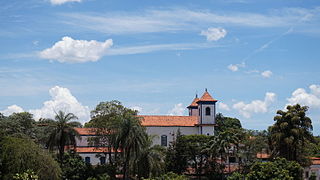
Sabará is a Brazilian municipality located in the state of Minas Gerais. The city belongs to the Belo Horizonte metropolitan region and to the associated microregion.
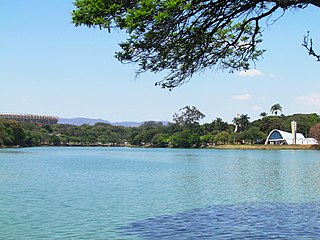
Lake Pampulha is an artificial lake located in Pampulha, Belo Horizonte, Brazil. It is also the name of an administrative region of Belo Horizonte, and the name of one of 29 neighborhoods (bairros) within the administrative region of the same name. The lake was built in the early 1940s during the mayoralty of Juscelino Kubitschek, later president of Brazil from 1956 to 1961. Pampulha was created as a source of water for the city of Belo Horizonte, but quickly became polluted.

Athos Bulcão was a Brazilian painter and sculptor. He was born in Rio de Janeiro.

The Gustavo Capanema Palace, also known architecturally as the Ministry of Education and Health Building, is a government office building in the Centro district of Rio de Janeiro, Brazil. As the first modernist project in Brazil, it is historically important to the architectural development of Modernism in Brazil and has been placed on Brazil's UNESCO tentative list.

The Roman Catholic Archdiocese of Belo Horizonte is an archdiocese located in the city of Belo Horizonte in Brazil.
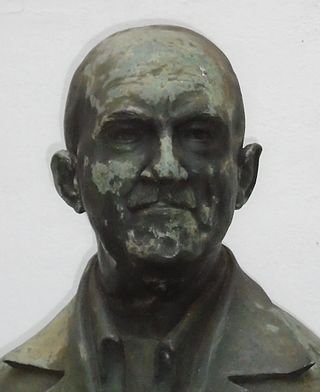
Alberto da Veiga Guignard also known as Alberto Guignard or Guignard was a Brazilian painter who became renowned for his depictions of the landscapes of Minas Gerais.
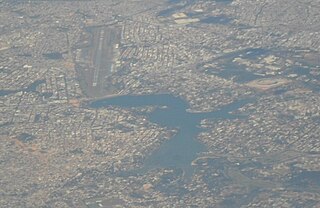
Pampulha is an administrative region in the city of Belo Horizonte, Brazil. It is one of nine administrative regions of Belo Horizonte, and occupies 47.13 kilometres (29.29 mi) in the northeast of the city. It has a population of 145,262 and a population density of 3.08 per square kilometer. The center of the Pampulha is occupied by Lake Pampulha, an artificial lake constructed in the early 1940s by Mayor Juscelino Kubitschek, later president of Brazil from 1956 to 1961. The Pampulha administrative region is further subdivided into 29 neighborhoods (bairros), one of which is also called Pampulha.

The Pampulha Modern Ensemble is an urban project in Belo Horizonte, Minas Gerais, Brazil. It was designed around an artificial lake, Lake Pampulha, in the district of Pampulha and includes a casino, a ballroom, the Golf Yacht Club and the Church of Saint Francis of Assisi. The buildings were designed by the architect Oscar Niemeyer, in collaboration with the landscape architect Roberto Burle Marx, Brazilian Modernist artists, and engineer Joaquim Cardozo.

The Pedregulho Housing Complex is an apartment complex and planned community in the Benfica neighborhood of Rio de Janeiro, Brazil. It was designed by the architect Affonso Eduardo Reidy (1909-1964). The project was planned in 1946 to house lower-paid civil servants of the city, which was then the Federal District of Brazil. Work commenced on the complex in 1949 and inaugurated in 1951/1952.
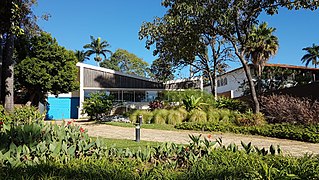
The Kubitschek Residence Museum is a museum house located on the shore of Lake Pampulha in Belo Horizonte, Minas Gerais, Brazil. The building served as the weekend residence of Juscelino Kubitschek, prefect of Belo Horizonte at the time.

Assunna Mosque is a mosque designed by Jean-François Zevaco in a modernist architectural style in Casablanca, Morocco in 1966. It features brutalist architectural elements such as raw concrete. It is located at the junction of Blvd. 2 Mars and Blvd. Modibo Keïta.

The Iate Tênis Clube is a recreational club located on the shore of the Lake Pampulha in Belo Horizonte. Its building was designed by architect Oscar Niemeyer in the early 1940s, integrating the Pampulha Architectural Complex, recognized by UNESCO as a World Heritage Site since 2016.

The Pampulha Art Museum, formerly known as Cassino da Pampulha, is a building that is part of the Pampulha Modern Ensemble located in Belo Horizonte, Minas Gerais, Brazil. The building was designed by the architect Oscar Niemeyer at the request of the then-mayor of the city, Juscelino Kubitschek, and is recognized by UNESCO as a World Heritage Site along with the rest of the ensemble since 2016.

The Casa do Baile is an architectural landmark in Belo Horizonte, Brazil, designed by Brazilian architect Oscar Niemeyer. It is part of the Pampulha Modern Ensemble, a complex of buildings constructed around Lake Pampulha in the 1940s that represents some of Niemeyer's earliest works in his distinctive modernist style utilizing curved forms. The Casa do Baile was inaugurated in 1943 as a restaurant and dance hall for popular entertainment, though it had a short lifespan in that role. After years of alternate uses, it reopened in 2002 as an architecture and design center. Its fluid curves integrating with the natural landscape have made it an icon of modern Brazilian architecture, garnering protected status at municipal, state and national levels.
TV Itacolomi was a commercial television station licensed to Belo Horizonte, capital of the state of Minas Gerais, and owned by Diários Associados. Throughout its entire operation, the station was a Rede Tupi affiliate.


























